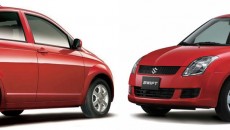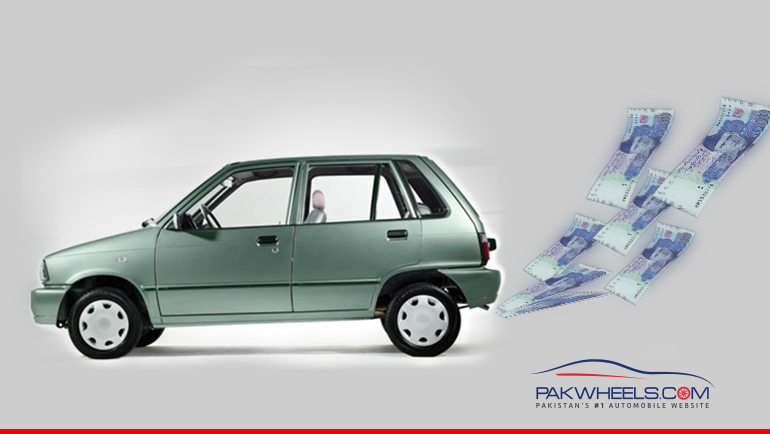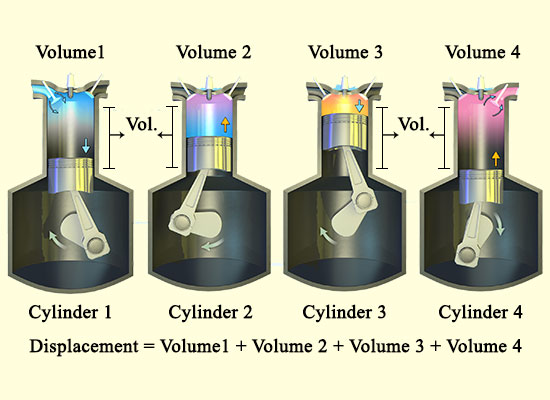Small Cars Might Not Be As Fuel Efficient As You Think They Are
When it comes to owning a car, fuel efficiency is a primary point of concern for most automobile users in developing countries like Pakistan. With the ever expanding cities of today, the distances we have to travel using our vehicles are on a rise. Most of us prefer to have a car which gives the best mileage, be it petrol or CNG, hence small cars with smaller engines are the ones found in majority here. But the question is, are the engines with smaller displacement actually fuel efficient?
There are certain perceptions developed in our market about vehicle segments and engine displacements, which needs to be corrected considering the technology that is available to us today. Here, regardless of the technology, majority of people still consider 1000cc or below engines to be fuel efficient, while 1300cc or bigger engines to be fuel guzzlers. However, this particular concept is not entirely correct. The fuel efficiency of a vehicle largely depends on the power-to-weight ratio, in addition to the displacement of the engine as believed.
Also Read: Few Tips Regarding Fuel Saving
The displacement of an engine is the volume of total air displaced by the pistons in all of an engine’s cylinders and is calculated in cubic centimeters, or liters. The output of an engine is measured in torque or horsepower. Torque measures the pulling power of an engine, while horsepower indicates how much sustained work the car can do. To put it in a simplest way, think of the engine displacement as a drink bottle, the bigger the bottle the more fluid you can put in it, and the more you are able to drink. Think of output as the amount of calories (energy) in that bottle. This should be able to help understand the basic concept of relationship between engine displacement with the output (Torque/ Horsepower).
While smaller engines may be fuel efficient in one way but in most circumstances they require more power to move around compared to the cars with bigger engines. A 660cc engine may need a lot of power from the engine, when it is loaded with say 5 passengers, air-conditioning, climbing uphill, accelerating at higher speeds, etc as compared to a larger engine. A 1300cc engine working under the similar circumstances will require much lesser effort to do its job. This results in more wear & tear and shorter engine life of a smaller engine as compared to the bigger engine.
Check Out: Small Cars for Sale in Pakistan
A study was carried out in UK last year. While drivers are often led to believe that smaller cars can travel more miles per gallon (mpg), research by Emission Analytics found that they often use up more fuel because they generally have to work harder to accelerate. Tests on 500 vehicles, half petrol, half diesel, each driven for three hours on roads in Britain, found that the cars traveled on average 18 percent fewer miles per gallon than stated in manufacturers’ specifications.
 It should also be kept in mind that modern day engines, with sophisticated technology are much more efficient in fuel consumption as compared to the smaller engines from couple of decades ago. Manufacturers deploy a certain engine into a vehicle considering the power-to-weight ratio. Most of the people in our market still believe that the 1300cc engine offered in hatchbacks these days aren’t fuel efficient, instead they should be offered with 1000cc engines as we are used to it. This concept is incorrect. The 1.3-liter found in a Suzuki Swift is offered because it can carry its weight and perform day to day tasks much easily & efficiently as compared to a 1.0 liter engine. However this does not lead to a conclusion that engines with higher displacement are always fuel efficient. Swift with a 1.6-liter engine will always require more fuel since the power it would develop will be more than the standard needs of a hatchback of this size. Similarly the Toyota Belta offered with a 1000cc engine is known to be sluggish in our market, as compared to the 1300cc version which has a slightly better power-to-weight ratio.
It should also be kept in mind that modern day engines, with sophisticated technology are much more efficient in fuel consumption as compared to the smaller engines from couple of decades ago. Manufacturers deploy a certain engine into a vehicle considering the power-to-weight ratio. Most of the people in our market still believe that the 1300cc engine offered in hatchbacks these days aren’t fuel efficient, instead they should be offered with 1000cc engines as we are used to it. This concept is incorrect. The 1.3-liter found in a Suzuki Swift is offered because it can carry its weight and perform day to day tasks much easily & efficiently as compared to a 1.0 liter engine. However this does not lead to a conclusion that engines with higher displacement are always fuel efficient. Swift with a 1.6-liter engine will always require more fuel since the power it would develop will be more than the standard needs of a hatchback of this size. Similarly the Toyota Belta offered with a 1000cc engine is known to be sluggish in our market, as compared to the 1300cc version which has a slightly better power-to-weight ratio.
The question now comes, why not the car makers give us the engine with the best power-to-weight ratio only. Toyota Corolla in our market is offered with 3 different engines, 1.3-liter, 1.6-liter and 1.8-liter. It’s because manufacturers offer different trims, configurations & engine options in a single car to cater to a wide variety of customers, some of whom prefer performance, others prefer economy. Since taxation of automobiles is based on engine displacement, vehicles with smaller engine displacement get the benefit and are largely preferred especially in developing countries.
We can calculate power-to-weight ratio by taking vehicle’s horsepower and divide it by its curb weight. The higher the number, the better your car is going to be in terms of performance. In addition to power-to-weight ratio, other factors like how you drive, vehicle maintenance, traffic conditions, quality of fuel and tire pressure etc also play an important role in determining fuel efficiency of a vehicle. It is because of this very reason that fuel consumption cannot be proportional to engine size in real world.
Though we have little options in our market, it’s always good to look for a product that fits your need rather than going after the herd and buy whatever everyone else is buying. People blindly believe that every 1000cc hatchback consumes less fuel than the 1300 hatchback, and every 1300cc sedan is fuel efficient than a 1500cc one. Here manufacturers don’t provide basic information like curb weight, power-to-weight ratio etc, at least not available on their websites and spec sheet. Rather than just looking for an engine with smaller displacement, consider its weight, horsepower/torque as well. While making a car buying decision, do keep in mind that bigger engines can yield better results than a smaller engine working under stress.






Brilliant article, I am facing the same problem since I converted from my 1300cc City to 1000CC hatchback. On my own going to and from office my new hatchback offers way better economy, but as soon as I have to sit 3 4 persons with me then theres problems and I remember the city. I guess the conclusion of the article should be that smaller engine hatchbacks are much more preferable if they are used for small daily routine traveling
I totally agree with the writer … I got Prado-96 it’s more fuel efficient than my Civic-Exi-05 …
Error in 2nd last para. carb weight/HP. lower the number , better the performance.
excellent article! Since you put it “Here manufacturers don’t provide basic information like curb weight, power-to-weight ratio etc, at least not available on their websites and spec sheet” – can you do a post listing the cars that are fuel efficient keeping in mind such specs.
The ignorant babu’s in tax and duty ministry are still stuck in the early fifties,.copying from the then British tax system which was based on post WW2 economics.
I totally agree with the writer. I own 1300cc car but my friend own 1800cc, and that give batter average per litter.
I have 2300CC Honda Accord.
Its Giving Me a milage of 15 on long with AC.At 150km/h
I have honda 70cc Euro II and it’s giving me a mileage of 70+km per liter
Well, cars in the big cities like Karachi & Lahore spend more time idling so smaller engines can be a better choice. If one travels long routes often then a bigger engine is a better bet.
Correct I own a 1800 cc Toyota and it gives 16-17 with AC on inter city routes. However, this requires speeds restriction i.e. up to 100 Kms
My 2014 Prado gives 10km/liter on intercity trip. Which is equivalent to 1300 cc cars.
The story is only partially true.
An unfit 1300cc is always going to consume more fuel than an unfit 660cc.
In Pakistan, mechanics do not use workshop manual neither they have proper tools, cars usually have out-of-tune engines, vacuum system is not up-to-mark, replacement vacuum pipes are substandard, fuel injectors are choked, spark plugs/wires/coils are third quality, thermostat is removed, quality spare parts are hard to come by (even if you want to pay the money for them, still you cannot find high quality spares), idle is rough, power delivery is not smooth. All this means that the engine is using much more fuel than optimal.
In addition, car makers put a smaller engine in the car because bigger engine means need of proportionally stronger clutch plate, gear box, axles (CV joints), larger capacity radiator, stronger timing assembly, maybe one more spark plug, one more fuel injector, one more piston, more piston rings, longer crank and cam, valve cover (here think of all the additional things in a 4-cyl vs 3-cyl scenario). Needless to say that a larger engine would require a larger block which would be costly in terms of weight of steel.
Carmakers save on many counts when they put in a smaller engine. They can even install narrow tyres and save money on rubber.
Town cars are always smaller (small body shape) because of congested roads, tighter turns, built-up area effect, less wind-buffeting and more expensive parking.
Highway cars, tourers, GT etc. are the opposite. Larger engines, larger body (for more room and comfort during the longer journeys), longer car gives more comfort, more stable in cross winds and more space is offered for all the luggage.
The main premise of the author is that the cars with same chassis are sold with larger engines in other parts of the world but because of the tax structure in Pakistan and the mind of the consumer that focuses on smaller and smaller engine, the manufacturers in Pakistan fit the cars with under-powered engines, which is NOT better for fuel economy contrary to popular belief NOR better for engine longevity.
another aspect to remember is that small cars made in pakistan like mehran, alto are very old technology, 660cc JDM cars or modern 1300cc when idle in traffic blocks reduce their fuel consumption to minimum, while a mehran with its motor made in 80’s ruins mileage when idle in traffic blocks, although it seems efficient when running.
is it correct
Good article. Simply speaking – newer technology is obviously more fuel efficient. I used too have an Alto VXR 1.0 Carby 1980’s SJ410 based engine from Paksuzuki. Do to its ancient engine it gave me a poor 9-10kmpl in city despite being a light weight car. Similarly even right now a Honda City 1.3 MT and 1.0-1.3 JDMs give better fuel economy than Mehran.
This hypothesis holds true for local assembled cars definitely.
However, newer ECO IDLE based small engine Japanese cars are becoming more and more fuel efficient. I.e a Mira 600cc ECO IDLE can easily touch 18kmpl.
Pakistan needs to catch up with the international market, we are lagging far behind all other countries. Selling 1980s models as 2015 is nothing to be proud of. Our Engineering industry has way more potential.. Competition and modernization/safety based regulations are direly needed.
Your statement stands true only if you compare 1300ccs with newer 660cc but in City traffic but in Pakistan the story is totally different the small cars assembled and sold here by Paksuzuki are globally obsolete vehicles from 1980s – and use old outdated technology.
Whole problem is we have no competition in under 1300cc segment and Paksuzuki has complete monopoly. If competition arrives and Paksuzuki’s share is decreased
The government has done a very miserable job as it has allowed just one company to have 100% market share in small car segment. Government should intervene using regulatory instruments to create competition and end dominance of one player.
A fuel efficient modern 1.3 to 1.5 vehicle with MT or CVT based transmissions can give up to 14-15 kmpl on a light foot. If you add an idle-stop system to it this figure can even go up to 17-18 in city. (however sadly there is no local assembled idle stop based car yet)
Nope, it is right. It is always Power to weight ratio and not weight to power ratio!
HP/ curb weight will be the right one!
Is that a 2.7 liter petrol engine?
Also, fuel consumption does not scale linearly with engine size.
For example, the 1.8L ZR-FE engine in the E170 Corolla gets only about 1L/100km better average in mixed real world use than a Camry with the 2AR-FE 2.5L engine (about a 17% improvement). However, compared to the 2.5L Camry, the 3.5L Aurion consumes almost 20% more whereas the engine capacity is almost 40% greater.
The weight of the car, the load it carries, the terrain you drive on, the quality of the fuel all play a role in real world fuel economy. A Land Cruiser with a 4.6L engine can consume close to 20L per 100km in city driving, whereas a Lexus LS460 with the same engine would be 15L/100km max because of differences in the dead weights of the vehicles…
Hey what model is your accord? Because my cl9 doesnt give good average whitn city
I have Cf3 with Newly Fitted F23A Vtec Engine.
What is the Milage of Ur Cl9 above 120km/h
And in City
the mode of government taxation is also wrong,,, they should be basing it on MPG rather than engine capacity…
I have come across the experience of wear and tear, Bigger engine going at a constant high speed like 120 km/hr with 5 passengers will last longer than a small engine. Hmmmm. thinking about taking apart mine (660CC EFI) and put bigger pistons, this will surely increase power to weight ratio. My car is the result of extensive experiments so don’t worry I have taken bigger risks than this one I am planning.
Will you believe me if I tell you guys I achieved about 21 km/litter out of a 660cc EFI fitted into mehran on long journey, only that I had to stay below 100 km/hr speeds, with five passengers.
thanks. yes perhaps another article in future might include the list.
You are right but why does my Mehran Euro II beat my 1.3 GLi so bad at mileage? Why is Mehran Pakistan’s most economical car?
But Honda and Toyota do give this info on site.
brilliant! looking forward to it.
We would like to know more about it..write to me at: [email protected]
Usman bhai, i think you must review your article. you are seemed UNAWARE of power v.s rpm and troque v.s rpm graphs of an engine and their corresponding fuel consumptions. Although i appreciate your effort.
The author rightly said, and just explaining the Newton’s 2nd law of motion i.e., F=ma. So, if you increase mass or acceleration of a vehicle you need more force which means more load on engine and as a result high fuel consumption.
What does curb-weight exactly mean in layman’s terms?
your article is good but it is really an issue that car manufacturer websites do not provide such information.
Also in Pakistan we have very limited choice to select vehicles with monopoly of only 3 Japanese companies in Pakistan i.e. Toyota,Honda and Suzuki
very informative article.
Power-to-weight ratio of mehran is greater than that of Gli… Author here compares two same cars having different engine specs 🙂
govt is only interested in kickbacks from automakers.
F=ma is an oversimplification.
“load on engine” should always in comparison to the capacity of engine. If a 1500cc engine is having load only equal to its 25% capacity, it will consume much less fuel than a (overloaded) 660cc at 120% load.
There is a reason why Bedford bus can do 7 km a litre which is same as an SUV but the size and load of both are entirely different.
Dear guest engineer, “load” is an important factor which we usually ignore.
At e.g. 2000 RPM with one person, the engine will not have much load and will be economical. But the same engine at 2000 RPM and same accelerator pressure will suck in more fuel if it is has 5 people and luggage in the trunk.
To add to the problem, the driver will press the pedal more and the smaller engine will b unable to produce neither enough power to propel the car nor enough power to propel itself to a higher RPM where it would be able to produce more power.
This is called overbore. It will thin out the walls of the block and thus reduce the life of the engine.
Will not help your cause.
Good written
the weight of a car without occupants or baggage is called curb/kerb weight.